Belle’ Lumiere
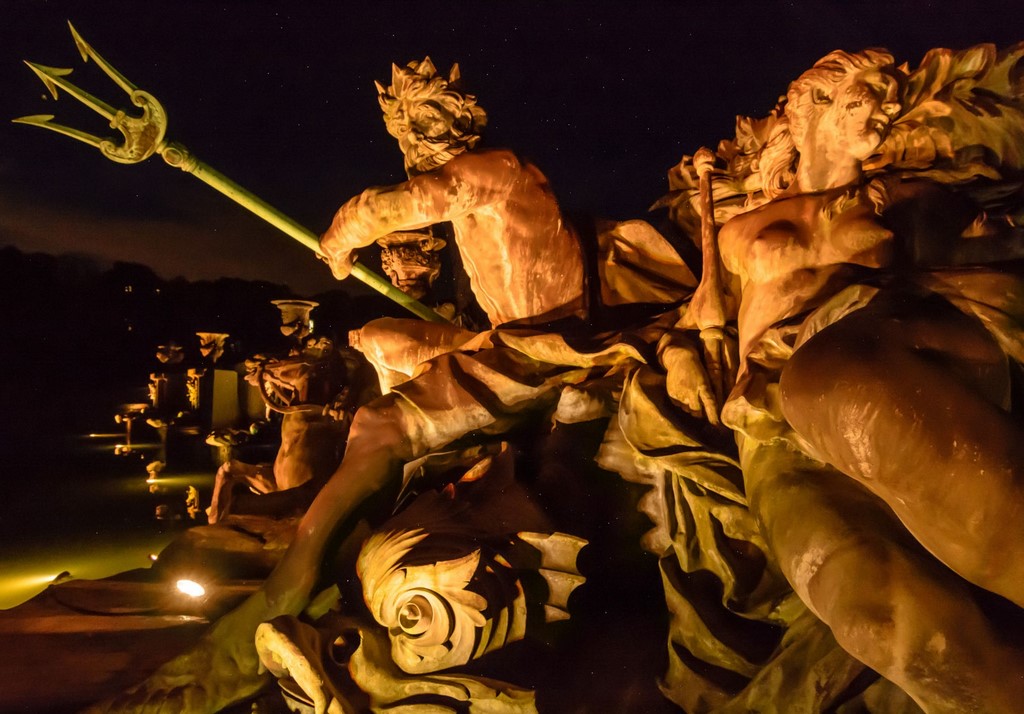

Lighting some of the most historic fountains on the planet is no small responsibility, reports David L’Heureux and George Ayer of fountain designer and manufacturer Crystal Fountains. Equipped with both the necessary experience and technology, the company was tapped to bring illumination to the legendary fountains of Versailles – and the results are beautifully illuminating.
The fountains of Versailles are among the world’s most iconic decorative bodies of water. Built in the 17th Century (largely in the 1670s), the 50 fountains that grace the palace grounds are among the most celebrated and photographed in the 800-hectar complex, perhaps second only to the palace chateau itself.
Built for Louis the XIV, the “Sun King”, by a cadre of the era’s greatest designers and artists – including Andre’ Le Notre, Charles Le Brun, Louis Le Vaue and Jules Hourdouin-Mansart – Versailles stands as one of the great achievements of the era.
The fountain systems, and the vast garden spaces they occupy, are impressive by any measure. There are 253 bronze, marble and stone sculptures in the gardens and fountains, making the property the world’s largest outdoor sculpture museum. The fountains include nearly 700 separate jets, which were originally powered by a system of water wheels with over 35 kilometers of plumbing that routed water from the River Seine, which remains the water source for the fountains to this day.
In effect, the fountains comprise one big interconnected system where water starts at the top of the sloping property and courses its way through all of fountains as it descends to the bottom. There are neither filters nor chemical treated systems. It is a massive, untreated, flow-through system.
BEFORE EDISON
Needless to say, there were no electric lights in the 17th Century either, and for generations, the fountains have been for the most part a day-time attraction. Throughout their history, the fountains were only lit occasionally using portable external landscape lights.
That began to change in 2014 and we’re proud to be an important part of that transition, working as both a consultant and equipment supplier.
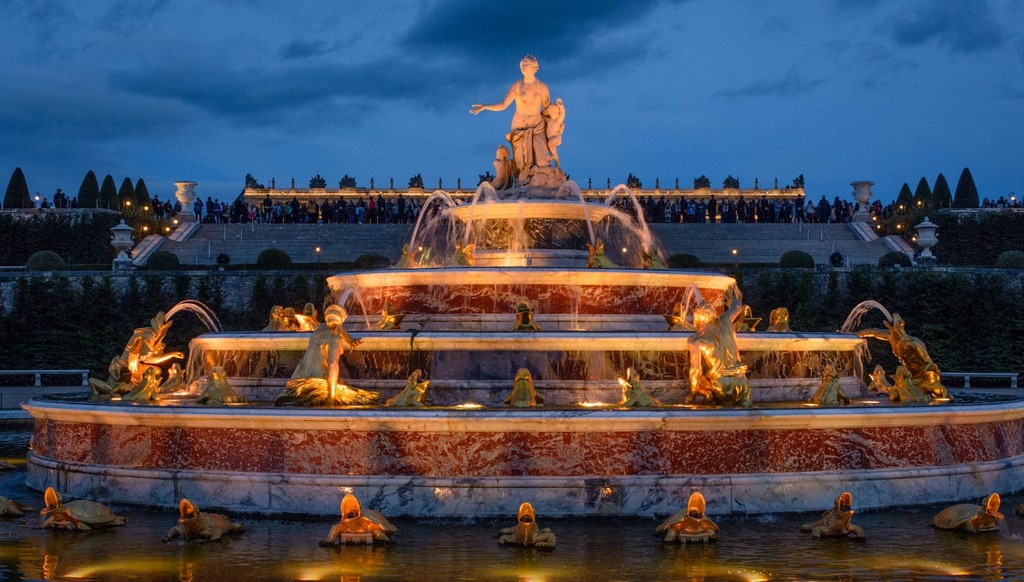 For generations, the palace has been run by the French government, meaning upkeep has always been more or less done on a shoestring.
For generations, the palace has been run by the French government, meaning upkeep has always been more or less done on a shoestring.
In visualizing the future of Versailles, the French government and people took a decidedly fresh approach. Our involvement, which began in 2014, is one of the many results of the change in direction.
In France, all municipal fountains have to be designed by a “fountain designer.” This is a formal professional designation, as opposed to the more general term, “aquatic designer” which what we have here in the North America.
Among those accredited design firms is JML Waterfeature Design, located in Barcelona, Spain. One of JML’s chief designers, with who we’ve worked several times, called us and said that he was working with a lighting designer in France who was tasked with lighting the Versailles gardens and fountains.
The client in this case, was (is) an organization called Chateau Versailles Spectacular (“Spectacular”), which was formed to incrementally upgrade the property over time and add revenue streams by staging a spectrum of different live events.
Since 2014, Spectacular has been adding permanent lighting to the landscape and fountains so that the property can be used as a venue at night. The company rents the gardens for special events to companies, wealthy individuals and non-profit organizations, and helps them stage what sometimes amounts to elaborate live productions.
The proceeds from the events are then used to continue the renovations. The basic idea is that the property will generate more revenue when people can stay longer.
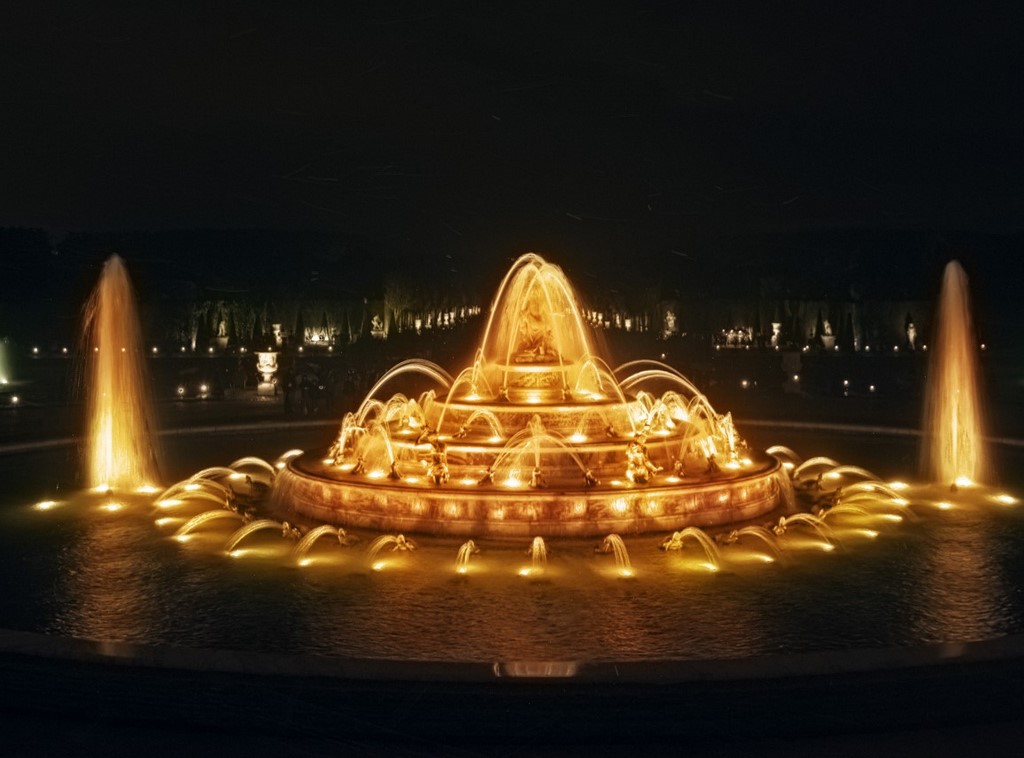 There’s an overall master plan to light the chateau, which is has mostly been done, and the gardens, which is going forward in phases because it’s such a big place.
There’s an overall master plan to light the chateau, which is has mostly been done, and the gardens, which is going forward in phases because it’s such a big place.
Every year, they light two or three more fountains and portions of the landscape.
Our role is to look at each fountain, determine the lighting needs for both water effects and sculpture, select the equipment, specify power needs and mounting hardware, and then sell the package to Spectacular, who has it installed along with the other landscape-lighting systems.
So far, the team has lit 14 of the most prominent fountains.
BATHING IN LIGHT
Over the years, we’ve developed a great relationship with Spectacular. They’re like a family dedicated to improving the property. The work is personal for them, nothing less than a point of national pride, and they are passionate about inventing a “brighter” future for Versailles.
We never lose sight of how fortunate we are to be a part of this ongoing project. We’re keenly aware they could work with any number of European underwater lighting companies. We go out of our way to provide an elite level of service and technical support.
Each year we visit the site to meet with Spectacular and their designers. We inspect the fountains they’ve selected to light that year. We do a lot of application testing as part of our design process. We bring in lights and test how the fountains will look. When they approve, we move forward.
From a purely technical standpoint, the work here is all about adaptation. On one hand, the technology is relatively simple because the fountains don’t “dance” the way that modern fountains do. The systems are designed to illuminate the fountain effects and the statuary with a combination of subsurface and above-the-surface LED fixtures.
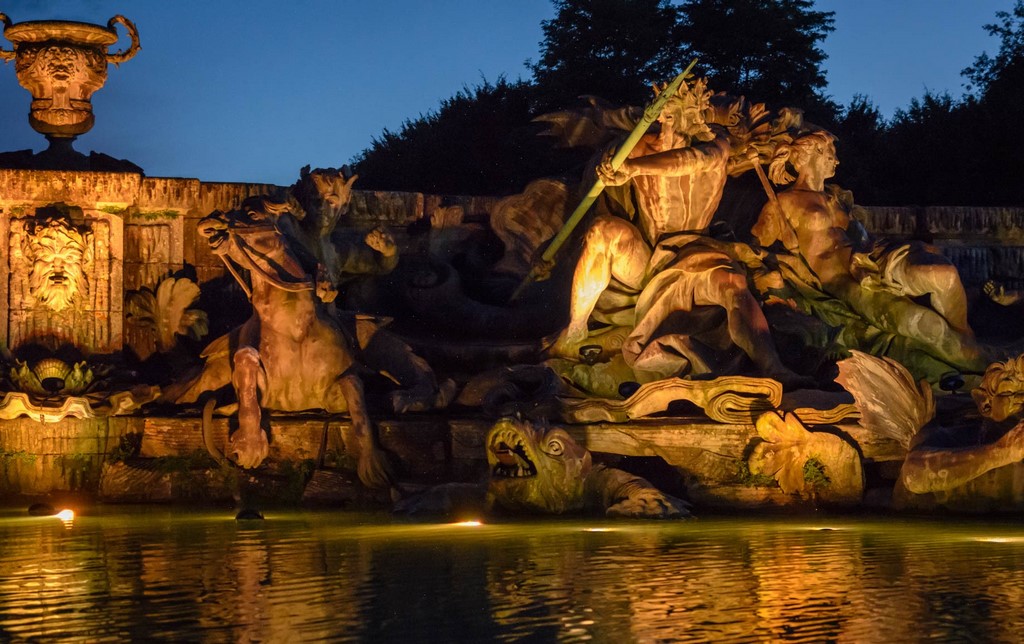 Lighting the fountains from within, means that, in effect, we are redefining the way the fountains look. Everyone involved knows that’s a huge responsibility, one that requires understanding the intent of the original design and then working to accentuate it.
Lighting the fountains from within, means that, in effect, we are redefining the way the fountains look. Everyone involved knows that’s a huge responsibility, one that requires understanding the intent of the original design and then working to accentuate it.
The first year, we provided lighting for five fountains. There was quite a variety of designs, which gave us an opportunity to use our equipment in different types of settings and conditions.
The second year we focused almost entirely on the Latone Fountain, arguably the most prominent on the entire property.
It’s one of the most photographed fountains in the world and is a central destination in the gardens. In 2016, we added over 100 lights to the feature, mostly submerged in the large basin surrounding the dramatic sculptures and famously lavish jets.
In subsequent years, we moved on to the intensely dramatic Neptune fountain; the fanciful Dragon fountain; the beautifully lyrical Nymph fountain, which is essentially a massive sheer-descent feature; and the iconic Apollo fountain – to name of few of the more significant ones, so far.
ADDING COLOR
Generally speaking, the advent of LED technology has changed everything — not only in fountain lighting, but in the entire lighting market, making this ongoing campaign feasible. The energy savings of LED lighting appeal to most everybody; but, in a project like this where there are literally thousands of lights, with potentially many times that number yet to be installed, saving money on energy is extremely significant.
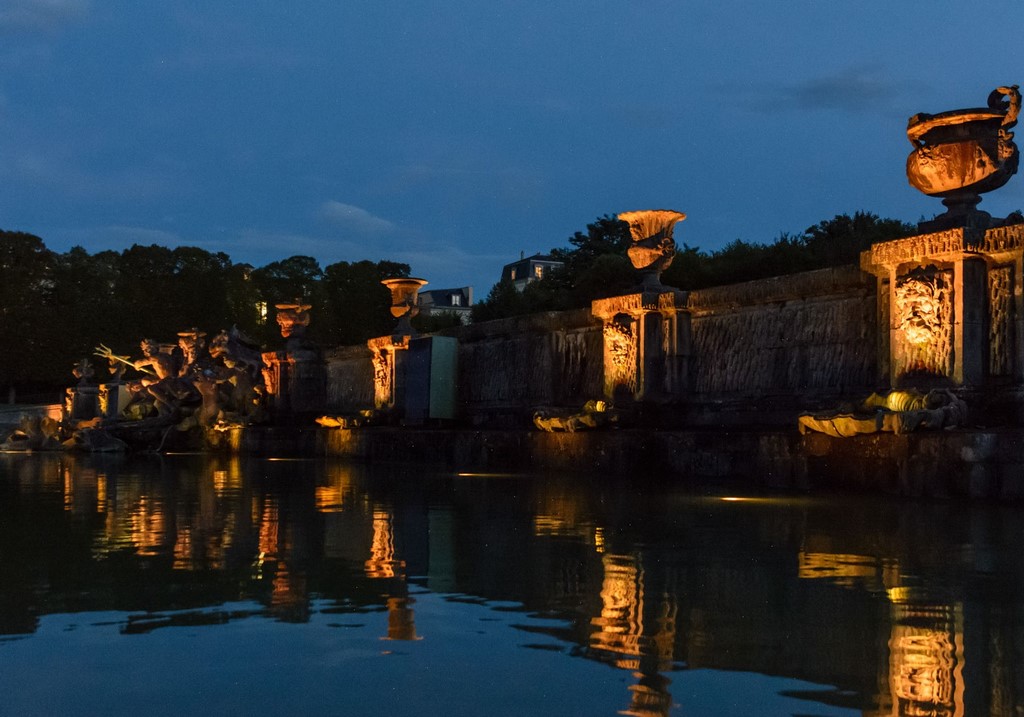 LEDs are getting stronger and stronger every year, while using less electricity. LEDs have also changed the shape of lights, literally. Halogen lights are shaped the way they are in the familiar bell shape because the housing is designed around the shape of the lamp itself. LEDs don’t have that limitation and can be any shape and are generally smaller. That also plays a part when you’re adapting lights in an historic setting.
LEDs are getting stronger and stronger every year, while using less electricity. LEDs have also changed the shape of lights, literally. Halogen lights are shaped the way they are in the familiar bell shape because the housing is designed around the shape of the lamp itself. LEDs don’t have that limitation and can be any shape and are generally smaller. That also plays a part when you’re adapting lights in an historic setting.
Not only are we adding light to fountains that were created during a time when nighttime illumination was by torch, candle or lantern, LED technology provides the ability to turn the fountains virtually any color.
For the most part, team stays with white light, which gives the flows and figures an appropriately classical look. But they can, and sometimes do, use color: red and green for Christmas, orange for Halloween, pink for breast cancer awareness events, etc. To be sure, there are so-called historic purists who do not appreciate the affectations of modern lighting, but from there’s no question adding light to these remarkable fountains adds an entirely new dimension to their appearance.
In selecting the components, we use a handful of “star players” that appear over and over throughout the fountains, which simplifies both installation and maintenance. Favorites include the highly versatile LED360, which we use both underwater and in dry applications that require extremely focused light, and one of our newer products, the LNL304 Spectra Linear, which can paint large surfaces and figures with evenly distributed light.
FIXTURE PLACEMENT
Because the water is untreated, it basically flows from the top of the system to the bottom, “participating” in all of the fountains along the way, it is not clear. In fact, it’s green. That means that when locating subsurface light, fixtures can only be an inch or two deep, at the most, otherwise the cloudy water will reduce the light and distort the color.
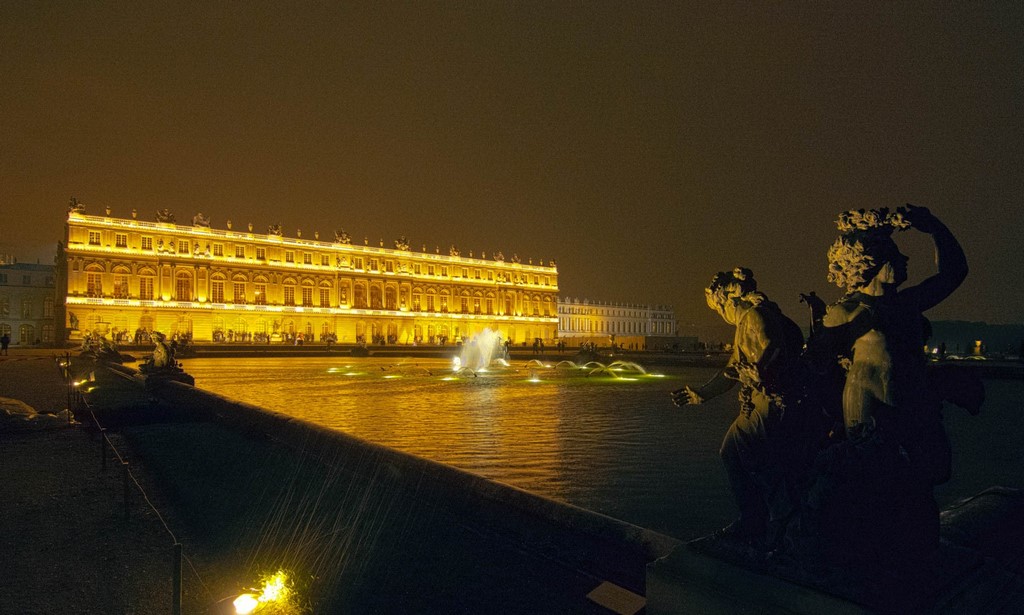 The challenge is that these basins are completely different from each other with depths that vary from less that a foot to almost chest deep in some places.
The challenge is that these basins are completely different from each other with depths that vary from less that a foot to almost chest deep in some places.
That means to achieve uniform lighting depth, you have to have lighting supports that range from a few inches to three or four feet. Some supports must be custom fabricated, while most are standard units.
The key is taking accurate measurements during the planning stage, which sometimes requires wading into the water with a measuring stick.
Over the years, we’ve found that when lighting fountains, especially big elaborate ones like those at Versailles, you can never get enough light. Virtually no one ever says they have too much light. Not only does the aforementioned turbid water impact net light output, many of the features have highly aerated plumes, sprays and streams, some that shoot 15 in the air or higher.
The frothier the water, meaning the more air entrained it is, the more light it requires. In the Apollo fountain, for example, we placed four fixtures at the base of each vertical plume to saturate the turbulent water with light.
In the lighting industry, designers use computer models and light output data to create extremely accurate computer simulations. This is difficult when it comes to water where the variables are difficult, or impossible, to calculate and quantify. We have experience dealing with the way water changes light, which many lighting designers lack. Our unique expertise in a project like this really comes to knowing which light to choose and where to put them.
Getting power to the fountain wasn’t a major challenge, because the entire landscape is being lit, so there is power running to most areas and directly to many fountain locations. Getting power inside the fountain was another story. We didn’t want to create new penetrations in the historical structures. We had to be creative and sometimes that means running the cabling over the edge of the fountain, usually in a discreet location. In other situations, we were able to find existing penetrations in the structure we could use.
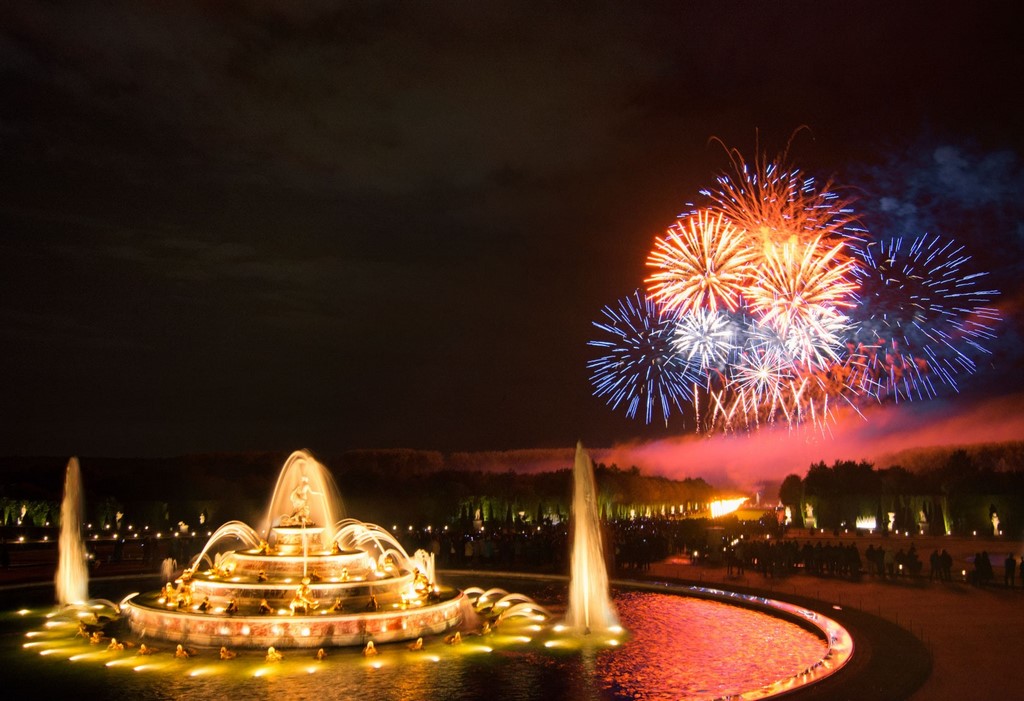 All of the technology, in the fountains and elsewhere, runs back to a master control room located in the Chateau. From there they control all the lighting, music and other theatrical elements that go into the events.
All of the technology, in the fountains and elsewhere, runs back to a master control room located in the Chateau. From there they control all the lighting, music and other theatrical elements that go into the events.
Our LED DMX controllers are part of the equipment array, where all the fountain lights can be controlled and programmed from a single location.
In a way, it’s ironic that all this state-of-the-art technology is used to illuminate fountains are around 350 years old. But, since Paris is known as the City of Lights, it all works to everyone’s delight after the sun sets.
Authors note: like so many endeavors, work at Versailles has been halted during the current pandemic. We have two or more fountains in the design phase, ready for installation when the world opens back up. We are confident many more will follow until most, or all of the fountains of Versailles are finally fully lit.
David L’Heureux is Crystal Founains’ co-owner and chief sales officer with more than 35 years of experience in the water feature industry. He has been personally involved in expanding the company’s international and domestic presence, which includes projects like the world-renowned Palace of Versailles, France, described in the above article. He has managed hundreds of successful water feature projects throughout North and South America as well as in Europe, the Middle East, Africa, and South East Asia with his advanced knowledge of the water feature industry.
George Ayer, P.Eng, is Crystal Fountain’s director of supply chain. He is a licensed professional engineer with over 30 years of experience in creating and leading innovative product design, manufacturing, and supply chain. His focus has included new product development, integrating mechanical systems, electronics, and control. Several designs have been patented. During his 20-plus year tenure, Ayer has introduced new product materials, manufacturing methods and technologies, “Fluidics,” LED lighting and DMX/RDM controls to Crystal’s product portfolio.









